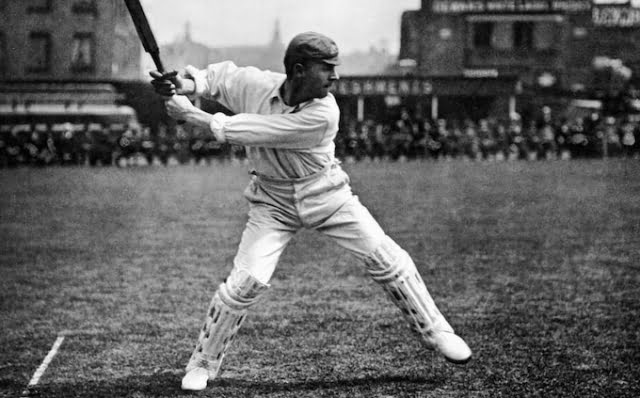 The great Australian Victor Trumper receives Player of the Year awards in 1899 and 1911. Photo: George Beldam/Popperfoto
The great Australian Victor Trumper receives Player of the Year awards in 1899 and 1911. Photo: George Beldam/Popperfoto
The last 12 months have been so significant for cricket in many ways that a significant new edition of Wisden should be expected and no one will be disappointed.
The 160th edition of the Almanac correctly captures the revolution in English Test cricket with the development of Buzzball — the determination of England captain and coach Ben Stokes and Brandon McCallum to transfuse blood for a near-final long-form game. revive it, and it brought great success.
It also explores the cannibalistic activities of international T20 franchises and reflects on the consequences of players who understandably feel motivated to put their personal enrichment ahead of their country; and notes the failure of the 100 to generate the interest its inventors had hoped for, compared to the huge sacrifices the regular home game had to make to get this bastard uniform into their schedules.
Reading Wisden one senses that a new and exciting dawn is dawning for cricket in England, but it is far from certain that those in charge of the game will want to notice. The book is over 1600 pages long and exudes variety in its content, not for the sake of displaying virtue.
RIP Shane Warne… and the two queens
Cricket has a huge culture due to its vast history, and both qualities seep from its pages. The Almanac did an excellent job of memorializing one of the greatest cricketers of all time who died last year: Shane Warne.
Out of luck for two other great men of all time, Rodney Marsh and Sonny Ramadin, who also died last year and who, if not for Warne, might have earned the attention to their lives that he enjoys in the opening section (later they both have detailed and excellent obituaries).
The late Queen also has an obituary based not only on her regular visits to the Lord's to meet her test cricketers from England and any Commonwealth team, but on what is claimed to have been a longtime sincere interest in the game . She even brought a brandy-soaked cake to the Special Test Match Team when she visited them in 2001.
And also, 122 years late, immortalized the obituary of Queen Victoria on the grounds that in the past the Almanac is shameful not to note the death of famous women associated with cricket: although one reads the obituary of Victoria without realizing, what was her own connection to cricket.
The book has some great feature articles. Neil Harvey, the last surviving «Invincible» or member of the 1948 Australian touring team with 31 first-class matches without defeat, writes of being part of Bradman's elite.
There's a report on what cricket is doing to help people with autism and, if you're longing to wake up, the game and climate change. Perhaps the most remarkable article about cricket in Ukraine is an aerial photograph of a field in Kharkiv brought there by Indian migrants, and the leadership of the country pleading for ICC recognition.
The International Criminal Commission should ignore the minor issue of the ongoing war hindering serious cricket activity and resolve it on moral grounds anyway. Veteran pundit David Frith, author of some of the best cricket books ever written, recalls how, 150 years after the birth of the legendary S.F. Barnes, he met the great man at the age of 92 at his home in Staffordshire in 1965. Retrospective Player of the Year Awards
Still thinking about history, there's a new but dated innovation: the Wisden Trophy for Test Cricketer of the Year, won this year by Johnny Bairstow.
Formerly, Wisden provides a list of who would have won the trophy every year from 1877 to 1939 if it had been awarded then (winners from the war to Bairstow will be listed next year to give us all a chance to compile own lists).
The trophy is thus retrospectively awarded twice to Spofforth (1879 and 1882), Trumper (1899 and 1911) and Barnes (1913 and 1914); and Bradman three times (1930, 1934, and 1937), possibly the fourth time that the 1948 verdict would be handed down.
Grace wins in 1880; Jessup in 1902, having received them «in singles»; Hammond in 1929 and Hutton in 1938. This is a great idea that people will argue about throughout the season.
Praise for the championship
Inevitably, endless pages appear, filled with accounts of completely forgotten and trivial one-day matches; but the Almanac also reminds us of the revealing season of what was to become the Cinderella of the English game, the County Championship.
As part of an exhaustive review of the various media and digital platforms that are currently spreading discussion and interest in the game (including podcasts, blogs, social media as well as the print press), the Almanac reminds us that it is likely that more people have watched county cricket last year than at any point in history thanks to the live streaming of games that began in the wake of the pandemic.
This was done without any apparent effect on attendance: and Wisden also quite rightly praises Warwickshire's initiative to join eight other counties to give members mutual entry rights.
“Perhaps there has never been a better time to watch four-day cricket,” the editor writes, and he is right. Elsewhere, the Almanac notes that the fantasy that crowds of people for various forms of instant cricket would shift to first-class play does not appear to have been realised.
Reduced interest in serious cricket has been avoided: but what's next? It seems obvious: first, stop pushing cricket to the sidelines of the season — this rainy April has already ruined the matches — and consolidate interest in it at a new level.
If he follows the example of the national baseball team, the number of his followers will grow even more. Last year was a great season with two trebles and one quad in the counties, the last being Sam Northeast in a stunning match between Leicester and Glamorgan at Grace Road where the home team scored 584 in the first innings and still lost : This is the kind of game that a true cricket fan would kill to watch.
Instead of the advice of desperation that recently talked about reducing the league match list to 12 or even 10 matches per season, expand to the point where each county plays everyone in its division twice — and if there should be divisions, two out of nine, so that there are 16 championship matches, and more tourist matches, and bring back the universities.
As our test cricket thrives, our top-notch system must provide a high level of talent play: and can do so in an attractive way that will win over new audiences.
All over the world, however, the picture is less rosy. Test cricket is still in serious decline outside of England, Australia and India. In other countries, it is cannibalized to provide lucrative sub-continental competitions, where the interest in playing for the country far outweighs quick money.
Wisden notes this, but does not yet raise his voice against it to the height that may yet become necessary. We have reinvented the test uniform in this country, and with any luck in the next year or two we will reinvent the county game to accompany it. If much of the cricket world follows suit, they will need the same radical and innovative leadership.






















































Свежие комментарии